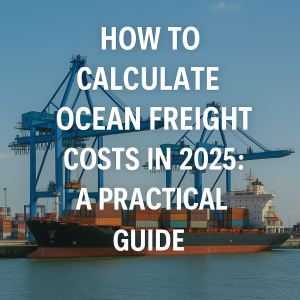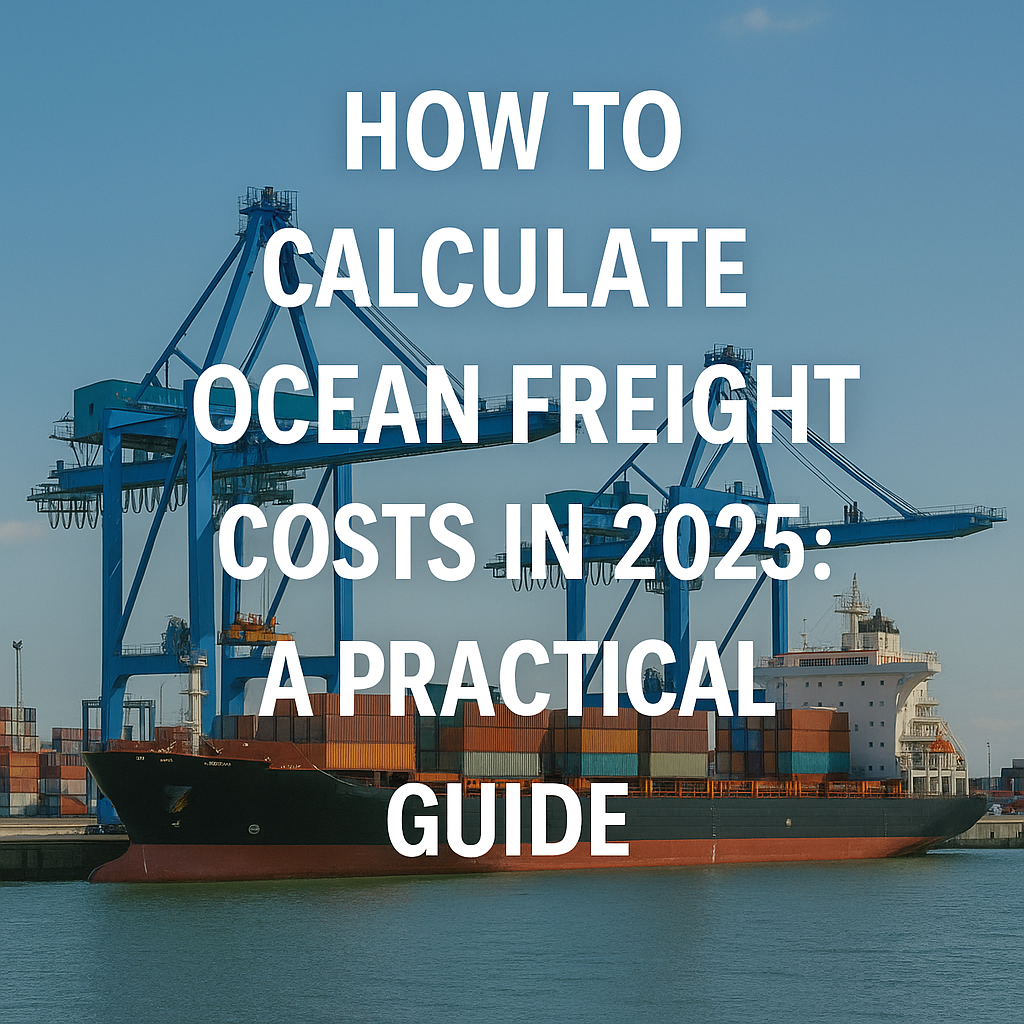Learn how to calculate ocean freight costs in 2025 with this practical guide. Understand key pricing components, real examples, and strategies to optimize global shipping expenses.”
In today’s global economy, ocean freight is the invisible conveyor belt that moves 90% of world trade. Whether you’re importing textiles from Vietnam, shipping electronics to Europe, or exporting grain from Canada, understanding how to calculate ocean freight costs is essential for budget control, competitiveness, and customer satisfaction. But in 2025, calculating these costs isn’t as straightforward as looking up a rate table. With volatile fuel prices, sustainability surcharges, fluctuating port fees, and digitized freight platforms, today’s shippers must be savvy, strategic, and informed.
This guide is designed for beginners, supply chain professionals, and business owners alike—explaining the components, influencing factors, tools, and recent trends that define modern ocean freight pricing.

Why Ocean Freight Cost Calculations Matter in Modern Maritime Logistics
Shipping may seem like a back-end function, but the price of ocean freight directly impacts retail costs, product margins, and delivery schedules. Inaccurate estimates can lead to unexpected charges, customs issues, or damaged supplier relationships.
According to UNCTAD’s 2024 Review of Maritime Transport, ocean freight costs rose by 15–25% globally between 2020 and 2023, driven by port congestion, fuel inflation, and climate-related delays. This cost sensitivity is especially critical for:
-
Small-to-medium enterprises (SMEs) looking to import/export efficiently
-
Retailers managing inventory in just-in-time (JIT) models
-
E-commerce brands relying on DDP (Delivered Duty Paid) shipping
Freight pricing also affects trade equity, with developing nations often facing higher per-unit shipping costs due to inefficient port access or container imbalances.
Understanding the Components of Ocean Freight Costs
Ocean freight isn’t a single number—it’s the sum of multiple charges. Let’s break it down:
Base Ocean Freight Rate
This is the core charge to move cargo from Port A to Port B. It depends on:
-
Route (e.g., Asia–Europe vs. Trans-Pacific)
-
Vessel type and space availability
-
Container size (20ft, 40ft, or high cube)
-
Seasonality (peak surcharges may apply)
Carriers publish these rates through freight forwarders, NVOCCs, or direct portals like Maersk Spot or Hapag-Lloyd Quick Quotes.
Common Surcharges and Fees
1. BAF (Bunker Adjustment Factor)
Reflects fluctuating fuel costs. Updated monthly or quarterly.
2. CAF (Currency Adjustment Factor)
Adjusts for currency exchange risks—especially relevant for USD-based contracts with EUR or RMB suppliers.
3. THC (Terminal Handling Charge)
Charged at origin and/or destination ports to cover container loading, unloading, and equipment handling.
4. PSS (Peak Season Surcharge)
Applied during high-demand shipping seasons, like August–October for holiday goods.
5. EBS (Emergency Bunker Surcharge)
Used during fuel crises or geopolitical disruptions (e.g., Red Sea crises or Suez Canal delays).
6. GRI (General Rate Increase)
Temporary price hikes announced by carriers, especially on volatile trade lanes.
7. Sustainability Fees (2025+)
With new IMO 2023 and CII regulations, many carriers are introducing Green Premiums or Carbon Intensity Fees to cover cleaner fuels or retrofitting expenses.
Calculating Freight Cost: Step-by-Step Example
Scenario:
You’re shipping a 40-foot container (FCL) of garments from Shanghai, China to Los Angeles, USA, in March 2025.
| Cost Component | Estimated Amount (USD) |
|---|---|
| Base Ocean Freight (Shanghai–LA) | $2,100 |
| BAF | $180 |
| CAF (5% on base + BAF) | $114 |
| THC at origin (Shanghai) | $145 |
| THC at destination (LA) | $190 |
| Documentation / Bill of Lading Fee | $75 |
| ISPS Security Charge | $12 |
| PSS (seasonal) | $150 |
| Total Estimated Freight Cost | $2,966 |
This estimate doesn’t yet include customs duties, inland haulage, demurrage, or warehousing.
Tools and Platforms for Real-Time Freight Quotes
Gone are the days of waiting three days for a freight quote. In 2025, you can get accurate, transparent quotes online through platforms like:
-
Freightos – instant FCL/LCL rates across multiple carriers
-
Flexport – digitally managed logistics with cost breakdowns
-
Maersk Spot – direct booking and pricing from Maersk Line
-
Shipwaves – popular in emerging markets (India, MENA)
-
Cogoport – AI-enhanced trade lanes and predictive pricing
These tools often include analytics, carbon calculators, and customs documentation support.
Case Study – Comparing Two Routes with Different Costs
Case 1: India to UAE – Short Haul Route
-
FCL 20ft container of ceramic tiles from Mumbai to Jebel Ali
-
Base rate: $500
-
Total freight cost: $820
Case 2: Vietnam to Germany – Long-Haul with Transshipment
-
FCL 40ft container of electronics
-
Base rate: $2,900
-
Transshipment (Singapore): $220
-
Green surcharge: $90
-
Total freight cost: $3,860
This highlights how transit time, routing, and port fees can dramatically change your bottom line.
Technologies and Innovations Impacting Freight Costs (2023–2025)
1. Digital Twins and AI Forecasting
Used by ports like Singapore and Antwerp, digital twins help forecast dwell times and port congestion—leading to more accurate pricing.
2. Blockchain-Based Smart Contracts
Projects like TradeLens and GSBN enable faster, tamper-proof billing and reduce fraud or manual errors in freight cost documents.
3. Greener Fuels and ESG Metrics
Under pressure from IMO, EU Fit for 55, and BIMCO, carriers are blending biofuels, testing methanol, and even trialing wind-assisted propulsion—but costs are passed to shippers via carbon fees.
“By 2024, 12% of global container fleets had adopted some form of alternative fuel propulsion,” — DNV 2024 Maritime Energy Report
Challenges and Cost Risks in Ocean Freight
Hidden Fees and Lack of Transparency
Many shippers get surprised by “add-ons.” Solution: Work with transparent forwarders and request all-in quotes.
2. Currency Volatility
Since many quotes are in USD, exchange rate swings can hit hard. Solution: Lock rates early or use forward contracts.
3. Port Congestion and Demurrage
If your cargo isn’t picked up in time, fees can rise fast. Some terminals now charge $100+ per container per day after the grace period.
Future Outlook: The Direction of Ocean Freight Pricing
As we move toward supply chain resilience and decarbonization, freight costs may stabilize—though likely at higher levels than pre-2020.
-
AI-driven pricing will become mainstream, adjusting rates in real time.
-
Green corridors (e.g., Rotterdam–Singapore) may offer cost incentives for sustainable shipping.
-
Governments may begin subsidizing low-carbon trade lanes, especially within EU, Canada, and Japan.
FAQ: How to Calculate Ocean Freight Costs
1. What’s the difference between FCL and LCL pricing?
FCL (Full Container Load) is flat-rated per container. LCL (Less than Container Load) is based on volume (CBM) and weight.
2. How do I estimate freight costs without a forwarder?
Use digital platforms like Freightos, Cogoport, or direct quotes from carriers like Maersk or MSC.
3. Are ocean freight rates negotiable?
Yes—especially for regular volumes or annual contracts. Use your shipment history as leverage.
4. What’s the average cost of a 40ft container in 2025?
As of Q2 2025, it ranges from $2,000 (short haul Asia–MENA) to $5,000 (long haul Asia–EU or U.S. East Coast), excluding surcharges.
5. Can I reduce costs by consolidating shipments?
Yes—grouping smaller shipments with others in an LCL can save on container fees, but delivery time may increase.
6. Do green surcharges apply to all carriers now?
Most major carriers have introduced them, especially on long-haul lanes. Some offer offset options.
7. How can I protect myself from surprise fees?
Ask for all-inclusive quotes, check Incoterms, and clarify who handles what—especially around customs, warehousing, and inland haulage.
Conclusion: Mastering Freight Cost Calculations in a Complex World
Calculating ocean freight costs in 2025 isn’t just about getting a number—it’s about understanding the many variables that go into that number.
From base freight to bunker surcharges, port handling to green fees, shippers need both tools and knowledge to stay competitive. The good news? With digital platforms, smarter analytics, and growing transparency, freight pricing is becoming more navigable than ever.
Your next step: Whether you’re planning a single shipment or scaling a global supply chain, build relationships with reliable forwarders, stay updated on regulatory changes, and always ask the right questions.
The ocean may be vast—but your shipping costs shouldn’t be a mystery.
References
-
UNCTAD. (2024). Review of Maritime Transport. https://unctad.org
-
DNV. (2024). Maritime Energy Transition Outlook. https://www.dnv.com
-
BIMCO. (2025). Freight Cost Trends and Sustainability Fees. https://www.bimco.org
-
TradeLens. (2024). Blockchain Logistics Innovation. https://www.tradelens.com
-
Freightos. (2025). Global Freight Index. https://www.freightos.com
-
Maersk. (2025). Spot Freight Booking Platform. https://www.maersk.com
-
British Ports Association (BPA). (2024). Port Infrastructure and Fees Update. https://www.britishports.org.uk
-
Inmarsat. (2023). Connected Maritime Logistics Systems. https://www.inmarsat.com



Thanks.
I am in fact thankful to the owner of this site who has shared this great piece of writing at at this time.
So glad I came across this page. I was struggling until I found your guide. You laid everything out step by step and didn’t miss anything. That’s real value. Appreciate it!